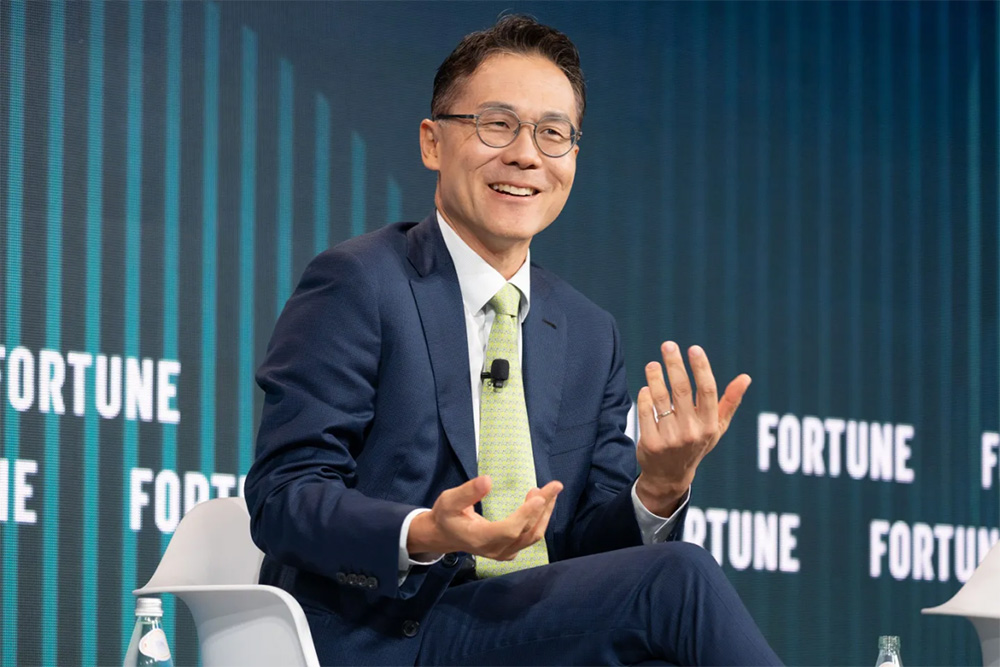
在達(dá)沃斯舉辦的世界經(jīng)濟(jì)論壇(World Economic Forum)上,亞洲的企業(yè)高管都在熱烈討論改變亞洲的各種力量,。當(dāng)前形勢(shì)堪稱風(fēng)云變幻,,美國(guó)新一屆政府提議修訂國(guó)際貿(mào)易體系;一家鮮為人知的中國(guó)初創(chuàng)企業(yè)打破了人們對(duì)人工智能的既有認(rèn)識(shí),;幾個(gè)亞洲國(guó)家剛剛公布,,2024年是有記錄以來最熱的一年。
21世紀(jì)或許確實(shí)是亞洲的時(shí)代,,回報(bào)可能相當(dāng)可觀,,但前提是做好充分準(zhǔn)備。以下是我與亞洲高管同行深入討論后梳理出的幾個(gè)關(guān)鍵議題,,未來一年將推動(dòng)亞洲發(fā)展,。
亞洲正面臨老齡化和萎縮
亞洲已實(shí)現(xiàn)歷史性里程碑:按購(gòu)買力平價(jià)計(jì)算,年家庭收入超過1萬美元的亞洲中產(chǎn)階級(jí)和富裕階層在總?cè)丝谥姓急冗^半,。消費(fèi)能力即將釋放,,為以消費(fèi)者為中心的企業(yè)以及背后的制造商提供巨大的增長(zhǎng)動(dòng)力,。
亞洲在全球GDP中的份額已從2000年的24%增長(zhǎng)到如今的37%,如果趨勢(shì)持續(xù),,到2040年比例將達(dá)到43%,。如此增長(zhǎng)正重塑貿(mào)易格局,打通新的貿(mào)易通道,,諸如越南與美國(guó),、中國(guó)與東南亞、日本與印度之間的貿(mào)易往來,。
但在這一積極趨勢(shì)背后,,伴隨著更具挑戰(zhàn)性的轉(zhuǎn)變,即生育率不斷下降,。如今,,全球三分之二的人口所在國(guó)家死亡率高于出生率。麥肯錫全球研究院(McKinsey Global Institute)稱,,日本和韓國(guó)的生育率尤其低,,在全球排名倒數(shù)。
到本世紀(jì)末,,日本人口可能減少超過30%,;中國(guó)人口萎縮幅度可能更驚人,到2100年將減少50%,。
企業(yè)紛紛根據(jù)人口縮減這一前提做決策,,日本和韓國(guó)的高管和初創(chuàng)企業(yè)創(chuàng)始人已將眼光轉(zhuǎn)向人口不斷增長(zhǎng)的海外市場(chǎng)。
隨著中國(guó)等傳統(tǒng)勞動(dòng)力大國(guó)面臨人口下滑的局面,,富有遠(yuǎn)見的領(lǐng)導(dǎo)者要借助人工智能和其他技術(shù),,發(fā)掘新的增長(zhǎng)機(jī)遇并提升效率。
南南貿(mào)易爆炸式增長(zhǎng)
當(dāng)今亞洲企業(yè)身處的政治環(huán)境截然不同,,亟需更細(xì)致的策略保持韌性,。傳統(tǒng)上捍衛(wèi)貿(mào)易的國(guó)家如今卻在抨擊貿(mào)易理念,這種情況下企業(yè)如何厘清發(fā)展方向,?
亞洲國(guó)家一大優(yōu)勢(shì)便是具備貿(mào)易多元化的能力,,既能向發(fā)展中國(guó)家出售商品,也能向發(fā)達(dá)國(guó)家銷售,。如今,,全球貿(mào)易中南南貿(mào)易占比達(dá) 20%,而且很可能迅速增長(zhǎng),。2019年至 2023年間,,中國(guó)與印度尼西亞、巴西和印度的貿(mào)易額年復(fù)合增長(zhǎng)率分別達(dá)到15%、12.1%和11.4%,。據(jù)報(bào)道,,中國(guó)與其他發(fā)展中市場(chǎng)的貿(mào)易額也實(shí)現(xiàn)了高個(gè)位數(shù)增長(zhǎng)。
過程中亞洲公司可真正實(shí)現(xiàn)全球業(yè)務(wù)布局,。以聯(lián)想為例:雖然聯(lián)想注冊(cè)地在香港,,但過去二十年間已發(fā)展成為全球性企業(yè),如今其中國(guó)業(yè)務(wù)僅占總業(yè)務(wù)的25%,。
我們很可能會(huì)看到更多這樣的公司,,尤其是中國(guó)公司,不僅在國(guó)內(nèi)市場(chǎng)發(fā)展壯大,,產(chǎn)品也銷售到新興市場(chǎng)和發(fā)達(dá)市場(chǎng),。
人工智能耗能巨大
2025年人工智能是最值得關(guān)注的趨勢(shì),為亞洲企業(yè)高管帶來了機(jī)遇和挑戰(zhàn),。全球各地的企業(yè)都在加緊利用生成式人工智能提高效率,,在客戶服務(wù)、銷售和信息技術(shù)等領(lǐng)域也已出現(xiàn)頗具潛力的應(yīng)用場(chǎng)景,。
亞洲越發(fā)強(qiáng)大的生成式人工智能技術(shù)正推動(dòng)娛樂和游戲行業(yè)爆炸性增長(zhǎng),。新技術(shù)為內(nèi)容創(chuàng)作者提供了強(qiáng)大且成本低廉的工具,可以更迅速地將創(chuàng)意推向市場(chǎng),。
不過人工智能也受到監(jiān)管層面和法律層面的審視,,尤其在版權(quán)和知識(shí)產(chǎn)權(quán)方面。最近不少媒體和娛樂公司針對(duì)人工智能開發(fā)者提起了一系列訴訟,,可能促使新的監(jiān)管框架和政策出臺(tái),。
對(duì)可持續(xù)能源的需求也引發(fā)不少擔(dān)憂。支撐人工智能的基礎(chǔ)設(shè)施,,也就是龐大且耗電的數(shù)據(jù)中心預(yù)計(jì)到2030年將消耗歐洲能源產(chǎn)出的5%,。亞洲和其他地區(qū)的消耗水平可能也差不多。
人工智能對(duì)能源的無盡需求會(huì)不會(huì)加劇可持續(xù)性問題,?還是說人工智能會(huì)催生新的解決方案,,推動(dòng)人類社會(huì)向更清潔、更健康且更具可持續(xù)性的環(huán)境邁進(jìn),?
亞洲企業(yè)領(lǐng)導(dǎo)如何生存
2025年消息傳播越發(fā)飛速,。有些變化可能預(yù)示著開展業(yè)務(wù)的方式將出現(xiàn)巨大變革,。而有些變化甚至可能一周內(nèi)就出現(xiàn)反轉(zhuǎn),,可能都用不了一周。亞洲企業(yè)的掌門人要胸懷希望與抱負(fù),,也要保持更加務(wù)實(shí)的態(tài)度,。
在達(dá)沃斯,我和同行們提出了當(dāng)今首席執(zhí)行官生存所需的六大特質(zhì):正能量、無私的領(lǐng)導(dǎo)力,、持續(xù)學(xué)習(xí),、韌性十足、管理的使命感,,還有很重要的一點(diǎn),,幽默感。
對(duì)于首席執(zhí)行官們來說,,這些要求不可謂不高,,但如今面臨的風(fēng)險(xiǎn)也前所未有。亞洲確實(shí)有可能迎來屬于亞洲的世紀(jì) ,,但只有在波濤洶涌的商海浪潮堅(jiān)定前行,,才能真正抓住機(jī)遇。
倪以理是麥肯錫全球資深董事合伙人,、中國(guó)區(qū)主席,。(財(cái)富中文網(wǎng))
譯者:夏林
在達(dá)沃斯舉辦的世界經(jīng)濟(jì)論壇(World Economic Forum)上,亞洲的企業(yè)高管都在熱烈討論改變亞洲的各種力量,。當(dāng)前形勢(shì)堪稱風(fēng)云變幻,,美國(guó)新一屆政府提議修訂國(guó)際貿(mào)易體系;一家鮮為人知的中國(guó)初創(chuàng)企業(yè)打破了人們對(duì)人工智能的既有認(rèn)識(shí),;幾個(gè)亞洲國(guó)家剛剛公布,,2024年是有記錄以來最熱的一年。
21世紀(jì)或許確實(shí)是亞洲的時(shí)代,,回報(bào)可能相當(dāng)可觀,,但前提是做好充分準(zhǔn)備。以下是我與亞洲高管同行深入討論后梳理出的幾個(gè)關(guān)鍵議題,,未來一年將推動(dòng)亞洲發(fā)展,。
亞洲正面臨老齡化和萎縮
亞洲已實(shí)現(xiàn)歷史性里程碑:按購(gòu)買力平價(jià)計(jì)算,年家庭收入超過1萬美元的亞洲中產(chǎn)階級(jí)和富裕階層在總?cè)丝谥姓急冗^半,。消費(fèi)能力即將釋放,,為以消費(fèi)者為中心的企業(yè)以及背后的制造商提供巨大的增長(zhǎng)動(dòng)力。
亞洲在全球GDP中的份額已從2000年的24%增長(zhǎng)到如今的37%,,如果趨勢(shì)持續(xù),,到2040年比例將達(dá)到43%。如此增長(zhǎng)正重塑貿(mào)易格局,,打通新的貿(mào)易通道,,諸如越南與美國(guó)、中國(guó)與東南亞,、日本與印度之間的貿(mào)易往來,。
但在這一積極趨勢(shì)背后,,伴隨著更具挑戰(zhàn)性的轉(zhuǎn)變,即生育率不斷下降,。如今,,全球三分之二的人口所在國(guó)家死亡率高于出生率。麥肯錫全球研究所(McKinsey Global Institute)稱,,日本和韓國(guó)的生育率尤其低,,在全球排名倒數(shù)。
到本世紀(jì)末,,日本人口可能減少超過30%,;中國(guó)人口萎縮幅度可能更驚人,到2100年將減少50%,。
企業(yè)紛紛根據(jù)人口縮減這一前提做決策,,日本和韓國(guó)的高管和初創(chuàng)企業(yè)創(chuàng)始人已將眼光轉(zhuǎn)向人口不斷增長(zhǎng)的海外市場(chǎng)。
隨著中國(guó)等傳統(tǒng)勞動(dòng)力大國(guó)面臨人口下滑的局面,,富有遠(yuǎn)見的領(lǐng)導(dǎo)者要借助人工智能和其他技術(shù),,發(fā)掘新的增長(zhǎng)機(jī)遇并提升效率。
南南貿(mào)易爆炸式增長(zhǎng)
當(dāng)今亞洲企業(yè)身處的政治環(huán)境截然不同,,亟需更細(xì)致的策略保持韌性,。傳統(tǒng)上捍衛(wèi)貿(mào)易的國(guó)家如今卻在抨擊貿(mào)易理念,這種情況下企業(yè)如何厘清發(fā)展方向,?
亞洲國(guó)家一大優(yōu)勢(shì)便是具備貿(mào)易多元化的能力,,既能向發(fā)展中國(guó)家出售商品,也能向發(fā)達(dá)國(guó)家銷售,。如今,,全球貿(mào)易中南南貿(mào)易占比達(dá) 20%,而且很可能迅速增長(zhǎng),。2019年至 2023年間,,中國(guó)與印度尼西亞、巴西和印度的貿(mào)易額年復(fù)合增長(zhǎng)率分別達(dá)到15%,、12.1%和11.4%,。據(jù)報(bào)道,中國(guó)與其他發(fā)展中市場(chǎng)的貿(mào)易額也實(shí)現(xiàn)了高個(gè)位數(shù)增長(zhǎng),。
過程中亞洲公司可真正實(shí)現(xiàn)全球業(yè)務(wù)布局,。以聯(lián)想為例:雖然聯(lián)想注冊(cè)地在香港,但過去二十年間已發(fā)展成為全球性企業(yè),,如今其中國(guó)業(yè)務(wù)僅占總業(yè)務(wù)的25%,。
我們很可能會(huì)看到更多這樣的公司,尤其是中國(guó)公司,,不僅在國(guó)內(nèi)市場(chǎng)發(fā)展壯大,,產(chǎn)品也銷售到新興市場(chǎng)和發(fā)達(dá)市場(chǎng)。
人工智能耗能巨大
2025年人工智能是最值得關(guān)注的趨勢(shì),,為亞洲企業(yè)高管帶來了機(jī)遇和挑戰(zhàn),。全球各地的企業(yè)都在加緊利用生成式人工智能提高效率,在客戶服務(wù),、銷售和信息技術(shù)等領(lǐng)域也已出現(xiàn)頗具潛力的應(yīng)用場(chǎng)景,。
亞洲越發(fā)強(qiáng)大的生成式人工智能技術(shù)正推動(dòng)娛樂和游戲行業(yè)爆炸性增長(zhǎng)。新技術(shù)為內(nèi)容創(chuàng)作者提供了強(qiáng)大且成本低廉的工具,,可以更迅速地將創(chuàng)意推向市場(chǎng),。
不過人工智能也受到監(jiān)管層面和法律層面的審視,尤其在版權(quán)和知識(shí)產(chǎn)權(quán)方面,。最近不少媒體和娛樂公司針對(duì)人工智能開發(fā)者提起了一系列訴訟,,可能促使新的監(jiān)管框架和政策出臺(tái)。
對(duì)可持續(xù)能源的需求也引發(fā)不少擔(dān)憂,。支撐人工智能的基礎(chǔ)設(shè)施,,也就是龐大且耗電的數(shù)據(jù)中心預(yù)計(jì)到2030年將消耗歐洲能源產(chǎn)出的5%。亞洲和其他地區(qū)的消耗水平可能也差不多,。
人工智能對(duì)能源的無盡需求會(huì)不會(huì)加劇可持續(xù)性問題,?還是說人工智能會(huì)催生新的解決方案,推動(dòng)人類社會(huì)向更清潔,、更健康且更具可持續(xù)性的環(huán)境邁進(jìn),?
亞洲企業(yè)領(lǐng)導(dǎo)如何生存
2025年消息傳播越發(fā)飛速。有些變化可能預(yù)示著開展業(yè)務(wù)的方式將出現(xiàn)巨大變革,。而有些變化甚至可能一周內(nèi)就出現(xiàn)反轉(zhuǎn),,可能都用不了一周。亞洲企業(yè)的掌門人要胸懷希望與抱負(fù),,也要保持更加務(wù)實(shí)的態(tài)度,。
在達(dá)沃斯,我和同行們提出了當(dāng)今首席執(zhí)行官生存所需的六大特質(zhì):正能量,、無私的領(lǐng)導(dǎo)力,、持續(xù)學(xué)習(xí)、韌性十足,、管理的使命感,,還有很重要的一點(diǎn),幽默感,。
對(duì)于首席執(zhí)行官們來說,,這些要求不可謂不高,但如今面臨的風(fēng)險(xiǎn)也前所未有,。亞洲確實(shí)有可能迎來屬于亞洲的世紀(jì) ,,但只有在波濤洶涌的商海浪潮堅(jiān)定前行,,才能真正抓住機(jī)遇。
倪以理是麥肯錫全球資深董事合伙人,、中國(guó)區(qū)主席,。(財(cái)富中文網(wǎng))
譯者:夏林
When I attended the World Economic Forum’s annual gathering in Davos last month, Asia’s business executives were buzzing about the forces transforming the region. It’s a busy time: A new U.S. administration is proposing to revise the international trading system, a little-known Chinese startup is puncturing narratives about AI, and several Asian countries just reported 2024 as their warmest year on record.
The 21st century may indeed belong to Asia, and the rewards could be enormous—but only for those who are prepared. Here are a few of the major themes, born from deep discussions with my Asian executive peers, that will drive the region in the coming year.
Asia is aging–and shrinking
Asia reached a historic milestone: The region’s middle and upper classes, defined as annual household income over $10,000 in purchasing power parity terms, now make up a majority of the population. That spending power is poised to be unlocked, powering both consumer-focused companies and the manufacturers that supply them.
Asia’s share of global GDP swelled from just 24% in 2000 to 37% today, and will reach 43% in 2040 if current trends hold. That growth is reshaping trade flows, creating new corridors between Vietnam and the U.S., China and Southeast Asia, and Japan and India, to name a few.
But this positive trend comes with a more challenging transition: falling fertility. Two-thirds of the world’s population now live in countries where mortality outpaces new births. Japan and Korea in particular have some of the world’s lowest fertility rates, according to the McKinsey Global Institute.
Japan’s population may shrink by more than 30% by the end of the century; China’s decline could be even more stark, with a 50% drop by 2100.
Businesses are already making decisions on the basis of a shrinking population, with executives and startup founders in Japan and Korea already looking at overseas markets with growing populations.
And as workforces in traditional powerhouses like China shrink, forward-thinking leaders will need to identify new growth opportunities and boost productivity using AI and other technologies.
South-south trade is exploding
Asia’s businesses are now operating in a very different political environment that demands a more nuanced approach to resilience. How can businesses navigate a world where trade’s traditional defenders now attack the idea?
One such upside that Asia’s countries have is the ability to diversify, selling to both the Global South and to the West. South-to-south trade now represents 20% of global commerce, and is likely to grow rapidly. Between 2019 and 2023, Chinese trade with Indonesia, Brazil, and India grew at an annual compound rate of 15%, 12.1% and 11.4% respectively. Growth in the high-single-digits is also being reported in trade between China and other markets in the global South.
And that will foster Asian companies with a truly global footprint. Take Lenovo: technically a Hong Kong-incorporated company, the PC manufacturer has evolved over the past two decades into a global multinational, with just 25% of its business in China today.
We should expect to see more companies like this, particularly from China, that grow and sell to not just their home market, but to emerging and developed markets alike.
AI gets power hungry
AI is the trend to watch for 2025, creating both opportunities and challenges for Asia’s business executives. Around the world, companies are doubling down on using generative AI for productivity gains, with promising use cases in customer service, sales and IT.
In Asia, increasingly powerful generative AI technologies are fueling explosive growth in entertainment and gaming. These technologies give content creators a set of powerful and affordable tools to more quickly bring their ideas to market.
But AI is also drawing regulatory and legal scrutiny, particularly regarding copyright and intellectual property. The recent spate of lawsuits from media and entertainment companies against AI developers will likely lead to the emergence of new regulatory frameworks and policies.
Demand for sustainable energy is also becoming a key worry. The infrastructure that sustains AI–sprawling, power-hungry data centers—is projected to consume 5% of Europe’s entire energy output by 2030. Similar patterns of power consumption are expected across Asia and other regions.
Will AI’s insatiable appetite for energy exacerbate the sustainability problem? Or will AI instead catalyze new solutions that will bring us closer to a cleaner, healthier and more sustainable environment?
How Asia’s CEOs can survive
News comes fast in 2025. Some changes could portend a massive transformation to how we do business. Other changes may be reversed within the week (if not in even less time). Asian CEOs will need to balance their hopes and aspirations with a more pragmatic attitude.
In Davos, my peers and I put forward the six traits the CEO today needs to survive: positive energy, selfless leadership, continuous learning, resilience, a belief in stewardship and, importantly, a sense of humor.
That’s a tall order for any CEO, but the stakes have never been higher. It really can be our century here in Asia—but only for those who can navigate these stormy waters.
Joe Ngai is a senior partner and chairman of McKinsey & Company Greater China.






